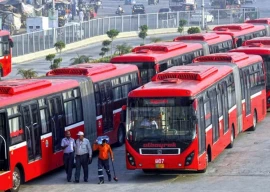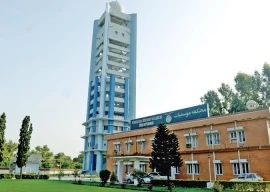
Basic accessories for basic necessities
However, the demand for bangles reduced as fashion trends evolved and now only a few women — from Afghanistan, Cholistan and other parts of the country — are seen selling bangles in the city.

The path across Balahissar Fort still sees scattered light bounce off glass bangles. A few women line the path, peddling some arm candy – their reason for being on the streets varying from husbands who do not work to becoming widows.
 Woman sells bangles in Peshawar. PHOTO: Muhammad Iqbal/Express
Woman sells bangles in Peshawar. PHOTO: Muhammad Iqbal/Express“We sell happiness but not enough that we can meet our basic needs,” Zubaida Bibi, one of the vendors, told The Express Tribune as she helped a woman try on bangles.
Zubaida Bibi was forced to sell these accessories as her husband does not want to work and asks her instead to earn for the family.
Zubaida Bibi, who is from Cholistan, said she started working soon after her marriage and was compelled to do so to feed her children. She sells a dozen bangles for Rs20 and gives two bangles for free on a dozen. She manages to make at least Rs700 to Rs800 per day with the sales.
Not all of these bangle vendors are comfortable with what they do.
“I do not like to sit outside on a footpath to earn money, but it’s our fate; we have to be out on the roads [to earn a living],” Hajra, another migrant selling bangles, said. Her job is made all the more difficult with men passing comments or staring at them with intent clear in their gaze, she said. “But there is no other option” – she has no other means to eke out a living for her survival.
The bangle sisters
Some of these vendors—mostly in rural areas of Peshawar district—go from house to house, carrying bangles on their head. Often women and girls can be seen gathering outside to buy bangles, glitter-coated and shiny glassy happiness. Yet it hardly seems correct to call them purveyors of happiness – what with so little that they have for their own joy.
Another source of income—quick and plenty—is houses where weddings are to take place.

“I like it when I go somewhere and people gather around me to buy my ware,” said Razia, who walks miles to earn a living. “I like how their faces light up when they see me.” Women in India and Pakistan still choose to accessorise with bangles on many occasions – not just weddings.
According South Asian Folklore: An Encyclopaedia: Afghanistan, Bangladesh, India by Peter J Claus, Sarad Diamond and Margaret Ann Mills, the styles of bangles not only signify ethnic affiliation, but can also be associated with social status. It states cheap and fragile glass bangles are worn by women of all classes as opposed to heavy bangles made of ivory that do not break easily and are generally worn by women involved in laborious activities.
Published in The Express Tribune, March 7th, 2016.






1725083820-0/Untitled-design-(24)1725083820-0-270x192.webp)
1725096749-0/Untitled-design-(1)1725096749-0-270x192.webp)









COMMENTS
Comments are moderated and generally will be posted if they are on-topic and not abusive.
For more information, please see our Comments FAQ